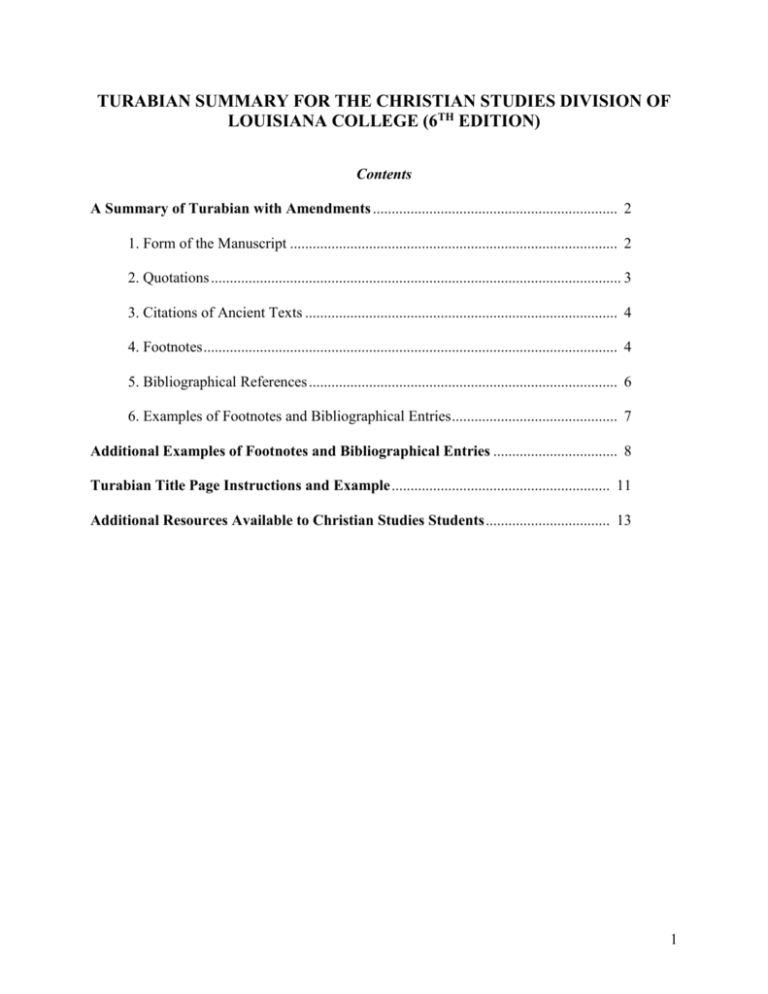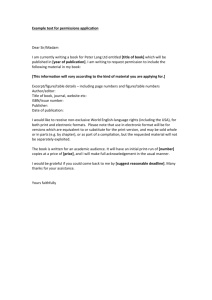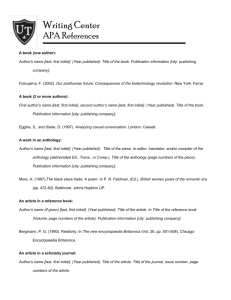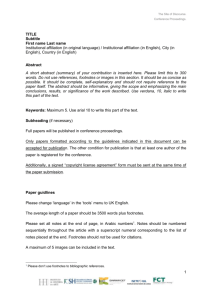a summary of turabian sixth edition
advertisement

TURABIAN SUMMARY FOR THE CHRISTIAN STUDIES DIVISION OF LOUISIANA COLLEGE (6TH EDITION) Contents A Summary of Turabian with Amendments ................................................................. 2 1. Form of the Manuscript ....................................................................................... 2 2. Quotations ............................................................................................................. 3 3. Citations of Ancient Texts ................................................................................... 4 4. Footnotes .............................................................................................................. 4 5. Bibliographical References .................................................................................. 6 6. Examples of Footnotes and Bibliographical Entries ............................................ 7 Additional Examples of Footnotes and Bibliographical Entries ................................. 8 Turabian Title Page Instructions and Example .......................................................... 11 Additional Resources Available to Christian Studies Students ................................. 13 1 A SUMMARY OF TURABIAN WITH AMENDMENTS PECULIAR TO THE CHRISTIAN STUDIES DIVISION AT LOUISIANA COLLEGE 1. Form of the Manuscript: 1.1. For English text, use Times New Roman font or an equivalent. Use 12 pt. for text and 10 pt. for notes (TS 13.27). 1.2. LC uses 8 space indention, and 4 space tabs (TS 14.3; Cf. 9.27; 14.13; 14:16). 1.3. LC uses a 1” margin on top, bottom, and right sides. Do not align right margin (TS 14.3). 1.4 Do not align/justify right margins (TS 14.3). 1.5. Number pages in the upper right corner (except for the first page number in a chapter or section, which is centered at the bottom margin) (TS14.8). 1.6. The text should be double-spaced except for block quotations, notes captions, and long headings, which should be single-spaced with a blank line between them. The first line of each note is to be indented. Bibliographical entries also are to be single spaced with a blank line between them. All lines except for the first of bibliographical entries are to be indented. (Select “hanging” under “special” in setting up paragraph format). 1.7. Do no underline titles if an italic font is available. Italicize titles of whole published works. Use quotations marks around titles of chapters or other parts of books and around journal and/or magazine article titles (T 8.38). Italic type also is to be used for foreign words, and transliterations. Italics for emphasis are to be used sparingly (TS 4.14; 8.38). 1.8. Headings for major sections of the paper usually begin two inches from the top of the paper (i.e. Chapters, Bibliography, Introduction, Table of Contents, etc). Use Arabic numerals for chapter numbers (T 14.10). 1.9. There should be two blank lines before a subhead text begins. Subhead title starts on 3d line below the preceding text (T/TS 14.12). There is one blank line after a subhead. 1.10. LC prefers no more than four levels of headings (two are even better). There is to be no more than six levels. Consistency is the key, but a standard sequence for LC is outlined below (TS 1.37): First level is bold and centered and headline style Traditional Controversy between Medieval Church and State Second level is centered in text type and headline style Reappearance of Religious Legalism 2 Third level is bold italic and headline style and begins at the left margin. Legalism and the Poets Fourth level is text type and sentence style and begins at the left margin. The gospel as it is related to Jesus Fifth level is indented, run-in, bold italic, and sentence style with a period at the end. The gospel legalized in the church. The gospel that…… Sixth level is indented, run-in, italicized, but not bold, and sentence style with a period at the end. The State’s reaction to the church’s preaching. The state… 1.10 Headline style (T 4.6-8) is capitalizing the initial letter of the first and last words and of all other words except articles, prepositions, and coordinate conjunctions (example 14.19). 1.11 Sentence style (T 4.9) is capitalizing only the initial letter of the subhead and of any proper nouns or proper adjectives (ex. 14.10). 1.12 A page should never end with a subhead nor should any single line end or begin any page (T 1.38). 1.13 Use a single space (not two) after periods, question marks, colons, and exclamation points when proportional font is used (Times New Roman; TS 3.54). 1.14 In a series consisting of three or more elements, the elements are separated by commas. When a conjunction joints the last two elements, a comma is used before the conjunction (T 3.68). 1.15 Distinguish between hyphens, en dashes, and em dashes (TS 3.91). The em dash (―) is the longest and is used to indicate a sudden break in though that disrupts the sentence structure (see 3.92). The en dash is longer than a hyphen but is shorter then the em dash and is used between inclusive numbers (e.g. 1–9). The hyphen (-) is the shortest of the dashes and is used for compound words and word division and omitted letters in text transcriptions. There are no spaces before or after dashes. 2. Quotations: 2.1 Quotations of two or more sentences and/or 8 or more lines of text in a paper should be in “block” format. Block quotes are set off from the text in single-spacing and indented in its entirely four spaces from the left margin, with no quotation marks at the beginning or the end. There are to be no opening and closing quotation marks. There are to be no block quotations in notes (T/TS 5.4). 3 2.2 The reader must always be told in the text who is being quoted, and most often the reader must be told why (TS 5.14, 5.30). 2.3 Periods and commas should be placed inside quotations marks; semicolons and colons go outside. Question marks and exclamation points should be placed outside quotation marks unless the question or exclamation is part of the quotation. (This is a general rule T/TS 5.17). 2.4 Accuracy in quotes is essential—wording, spelling, capitalization, and punctuation (T/TS 5.3). 3. Citations of Ancient Texts: 3.1 Use Arabic not Roman numerals in biblical citations. 3.2 Use a period for classical references and other literary references, but always a colon for biblical references at LC (TS 2.21). For example, Rom 6:4 but Homer, Odyssey 9.266– 71. 3.3 When referring to whole chapters or to whole books of the Bible or Apocrypha, spell out the names of the books (do not italicize or underline them). The abbreviations for them are to be used only when chapter and verse references follow (T/TS 2.20–21). 3.4 When scriptural passages are cited by verse in a paper, follow the chapter and verse numbers with the abbreviation for the version of the Bible or Apocrypha from which the passage was taken (T2.21). 3.5 See SBL style manual for standard classical and biblical abbreviations (TS 2.21). Do not place a period after the abbreviation (Gen 1:15–16). 3.6 For Greek and Latin classical works place a comma after the author’s name (TS 8.122). 4. Footnotes (see chapters 8 and 11): 4.1 Footnotes should be numbered consecutively, single spaced with a blank line in between each note, with the first line indented (TS 8.15). 4.2 LC requires footnotes and bibliography (TS 8.2). 4.3 LC requires superscript numbers (TS 8.7 & 8.10). 4.4 Note numbers always follow marks of punctuation (however, they do precede a dash; T 8.9). 4.5 If possible, a note number should come at the end of a sentence, or at least at the end of a clause (T 8.11). 4.6 A footnote must begin on the page where it is referenced (TS 8.15). 4 4.7 After the first full reference, a short form is used—use full words rather than acronyms or initials (TS 8.20, 8.22, 8.84–96). 4.8 The author’s name must appear in the reference (T/TS 8.26). 4.9 Do not underline title if an italic font is available. Italicize title of whole published works. Use quotation marks around titles of chapters or other parts of books and around journal and/or magazine article titles (TS 8.38). 4.10 Notes and bibliographies are to include reprint information and also give the date of the original publication and if possible the original publisher. Original data comes first, then reprint information. Do note cite new printings by the same publisher, only new editions (T/TS 8.46). 4.11 LC considers multi-volume Bible commentaries as examples of a series, and students citing them should follow 8.50. The basic style is to cite the author’s name, title, commentary series name, volume numbers, and the normal publication date (TS 8.50). Do not include editor’s names; do not italicize commentary set names. 4.12 LC prefers separate footnotes to be used—do not use one note for a paragraph containing several quotations (TS 8.14, 8.16). 4.13 Use of “Ibid.” is allowed (not italicized or underlines). However, students are to avoid the use of “idem.” “Ibid.” is used when references to the same work follow one another with no intervening references, even though they are separated by several pages, ibid. may take the place of the author’s name, the title of the work, and as much of the succeeding material as is identical. The author’s name and the title are never used with “Ibid.” (T & TS 8.85–86). 4.14 Both notes and bibliographical references follow the following patterns. In note references, the elements below are separated by commas (except for facts of publication which are separated by parentheses). Also, the comma following the book title or designation of edition is replaced by the opening parenthesis or the publication facts. In Bibliography, the elements are separated by periods. 4.15 T 8.24—First reference of a book should include the following information in the order shown: Name of author (s) Title and (if any) subtitle Name of editor, compiler, or translator, if any Number or name of edition, if other than the first Name of series in which book appears, if any, with volume or number in the series. Facts of publication, consisting of Place of publication 5 Name of publication Name of publishing company Date of publication Page number(s) of specific citation 4.16 T 8.99—First full reference to an article in a periodical generally includes the following facts in the order shown: Author(s) Title of article Title of periodical Volume or issue number (or both) Publication date Page number (s) 4.17 Examples are given at the end of this summery. 5. Bibliographical References (see chapters 8 and 11): 5.1 Normally use BIBLIGRAPHY or heading, all caps, no bold. However, more descriptive titles are allowed (TS 9.2). 5.2 See above patterns for bibliographical references. Remember that the elements are separated by periods. 5.3 Arranged alphabetically by authors’ last names, letter by letter; in the case of identical last names alphabetize next by given name (T 9.14). 5.4 “In succession of works by the same author, the name is given for the first entry, and an eight-space line followed by a period takes place in subsequent entries.” Arrange alphabetically by title or chronologically. When alphabetizing titles, disregard introductory articles (T 9.27). 5.5 Do not intersperse works edited by the author or written in collaboration with others with works by the author alone. In a list which includes all three categories, the author’s own works come first, then edited works (use an eight-space line followed by a comma, a space, and “ed.”). Translations follow (8 space, comma, and “trans.”) and then compilations (8 space, comma, and “comp.”; T 9.28). 5.6 Do not use an 8 space line for co-authored works (unless you are referring to all the names for subsequent works by the same combination of authors). Co-authored books follow edited, translated, and compiled works (T 9.29). 6 6. Examples of Footnotes and Bibliographical Entries: FOOTNOTES 1 Timothy George, The Theology of the Reformers (Nashville: Broadman, 1988), 15. Kenneth Scott Latourette, A History of Christianity; to AD 1500, vol. 1 (San Francisco: Harper, 1975; reprint, 2000), 115–88. 3 Charles A. Wanamaker, The Epistles to the Thessalonians, New International Greek Testament Commentary (Grand Rapids; Eerdmans; Carlisle: Paternoster, 1990), 23. Duane Warden, “The Rich and Poor in James; Implications for Institutionalized Partiality,” Journal of the Evangelical Theological Society 43 (2000): 247–57. 4 5 Gerhard von Rad, Old Testament Theology, 2 vols. (New York: Harper & Row, 1962– 65). Nils A. Dahl, “Eschatologie und and Geschichte im Lichte der Qumrantexte,” in Zeit und Geschichte; Dankesgabe an Rudolf Bultmann zum 80. Geburtstag, ed. Erich Dinkler (Tübingen: Mohr-Siebeck, 1964), 3–18. 6 Robert Prescott-Ezickson, “The Sending Motif in the Gospel of John: Implications for Theology of Mission” (Ph.D. diss., Southern Baptist Theological Seminary, 1986), 76–80. 7 BIBLIOGRAPHY Dahl, Nils A. “Eschatologie und Geschiechte im Lichte der Qumrantexte.” In Zeit und Geschichte: Dankesgabe an Rudolf Bultmann zum 80. Geburtstag, ed. Erich Dinkler, 3– 18. Tübingen: Mohr-Siebeck 1964. George, Timothy. The Theology of the Reformers. Nashville: Broadman, 1988. Latourette, Kenneth Scott. A History of Christianity; to AD 1500. Vol. 1. San Francisco: Harper, 1974. Reprint, 2000. Prescott-Ezickson, Robert. “The Sending Motif in the Gospel of John; Implications for Theology of Mission.” Ph.D.diss., Southern Baptist Theological Seminary, 1986. Wanamaker, Charles A. The Epistles to the Thessalonians. New International Greek Testament Commentary. Grand Rapids: Eerdmans; Carlisle: Paternoster, 1990. Warden, Duane. “The Rich and Poor in James: Implications for Institutionalized Partiality.” Journal of the Evangelical Theological Society 43 (2000): 247–57. Von Rad, Gerhard. Old Testament Theology. 2 vols. New York; Harper & Row, 1962–65. 7 Additional Examples of Footnotes and Bibliographical Entries N = Footnote/Endnote (Remember that the first line of each note is indented) B = Bibliography *Refer to the Turabian Manual for more information. Single-Author Book: 1 N Author, Title of Work (Place of Publication: Publishing Company, Publication Date), Page. 1 John Hope Franklin, George Washington Williams: A Biography (Chicago: University of Chicago Press, 1985), 54. B Author. Title of Work. Place of Publication: Publishing Company, Publication Date. Franklin, John Hope. George Washington Williams: A Biography. Chicago: University of Chicago Press, 1985. Two to Three Authors Book: 2 N Author, Author, and Author, Title of Work (Place of Publication: Publishing Company, Publishing Date), Page. 2 Mary Lyon, Bryce Lyon, and Henry S. Lucas, The Wardrobe Book of William de Norwell, 12 July 1338 to 27 May 1340, with the collaboration of Jean de Sturler (Brussels: Commission Royale d’Histoire de Belgique, 1983), 42. B Author, Author, and Author. Title of Work. Place of Publication: Publication Company, Publishing Date. Lyon, Mary, Bryce Lyon, and Henry S. Lucas. The Wardrobe Book of William de Norwell, 12 July 1338 to 27 May 1340. With the collaboration of Jean de Sturler. Brussels: Commission Royale d’Histoire de Belgique, 1983. Four or More Authors Book: 3 N Author and others, Title of Work (Publishing Place: Publishing Company, Date), Page. 3 Martin Greenberger and others, eds., Networks for Research and Education: Sharing of Computer and Information Resources Nationwide (Cambridge: MIT Press, 1974), 50. B Author, Author, Author, and Author. Title of Work. Publishing Place: Publishing Company, Publishing Date. 8 Greenberger, Martin, Julius Aronofsky, James L. McKenney, and William F. Massy, eds. Networks for Research and Education: Sharing of Computer and Information Resources Nationwide. Cambridge: MIT Press, 1974. Journal Article: 4 N Author, “Title of Article,” Title of Journal Volume Number (Year): Page. Richard Jackson, “Running down the Up-Escalator: Regional Inequality in Papua New Guinea,” Australian Geographer 14 (1979): 180. 4 B Author. “Title of Article.” Title of Journal Volume Number (Year): Pages. Jackson, Richard. “Running down the Up-Escalator: Regional Inequality in Papua New Guinea.” Australian Geographer 14 (1979): 175-184. Magazine Article: 5 N Author, “Title of Article,” Title of Magazine, Day Month Year, Page. Bruce Weber, “The Myth Maker: The Creative Mind of Novelist E. L. Doctorow,” New York Times Magazine, 20 October 1985, 42. 5 B Author. “Title of Article.” Title of Magazine, Day Month Year, Page. Weber, Bruce. “The Myth Maker: The Creative Mind of Novelist E.L. Doctorow.” New York Times Magazine, 20 October 1985, 42. Thesis or Dissertation: 6 N Author, “Title of Work” (Type of Dissertation, Place of Dissertation, Publication Date), Page. Gilberto Artioli, “Structural Studies of the Water Molecules and Hydrogen Bonding in Zeolites” (Ph.D. diss., University of Chicago, 1985), 10. 6 B Author. “Title of Work.” Type of Dissertation, Place of Dissertation, Publication Date. Artioli, Gilberto. “Structural Studies of the Water Molecules and Hydrogen Bonding in Zeolites.” Ph.D. diss., University of Chicago, 1985. Website: 9 N Author, Date Last Updated, Title of website page (Place of Publication: Publishing Company), Available from Internet, <name 9 website>, Access Date. 9 Tim Lynch, 1996, DS9 Trials and Tribble-ations review (Peoria, IL: Bradley University), Available from Internet, <http://www.bradley.edu/campusorg/psiphi/DS9/ep/503r.html>, Accessed 8 October 1997. B Author. Date Last Updated. Title of website page (Place of Publication: Publishing Company), Available from Internet. <name website>. Access Date. Lynch, Tim. 1996. DS9 Trials and Tribble-ations Review (Peoria, IL: Bradley University). Available from Internet. <http://www.bradley.edu/campusorg/psiphi/DS9/ep/53r.html>. Accessed 8 October 1997. 10 TURABIAN TITLE PAGE INSTRUCTIONS AND EXAMPLE All lines of the title page should be in capital letters. The name of the university or school the paper was written for or at is located on Line 1 or near the top of the page. The title of the paper should be around line 5. The type of paper that this is should be addressed at around line 12. (For example, it may simply be a “paper”, or it could be a briefing paper, a capstone paper, a thesis, a dissertation, etc. Refer to the assignment handout to find if the instructor has titled the paper as anything specific.) Specify who the paper is submitted to on the very next line. This is usually the instructor. The department of learning that the paper is being submitted to is specified around line18. For example, the Department of Political Science, Sociology, History, etc. The author is specified around line 26. Do not simply put your name, but also make sure the word “By” is there. You can also put a space between the word “By” and your name. The city and state of the university are placed around line 32. The due date of the assignment can be placed, with the day first, then the month, and finally the year at around line 34. There should be no commas. It is important to remember that the title page should be aesthetically pleasing. The line numbers mentioned are simply an approximation, and care should be taken that the entire page is reviewed several times. Using the Print Preview option can be especially helpful in your review process. 11 LOUISIANA COLLEGE THE SIGNIFICANCE OF THE NEW BIRTH FOR THE SALVATION OF SINNERS A RESEARCH PAPER PRESENTED TO DR. ALEXANDER COTTON DIVISION OF CHRISTIAN STUDIES BY PETER M. PARKER PINEVILLE, LOUISIANA NOVEMBER 8, 2010 12 ADDITIONAL RESOURCES AVAILABLE TO CHRISTIAN STUDIES STUDENTS (In the Office of Christian Studies) Alexander, Patrick H., et al. The SBL Handbook of Style: For Ancient Near Eastern, Biblical, and Early Christian Studies. Peabody, MA: Hendrickson, 1999. Strunk, William and E. B. White. The Elements of Style. 4th Edition. New York: MacMillan, 2000. Turabian, Kate L. A Manual for Writers of Research Papers, Theses, and Dissertations: Chicago Style for Students and Researchers. 7th Edition. Chicago and New York: The University of Chicago Press, 2007. William Zinsser. On Writing Well: The Classic Guide to Writing Nonfiction. 7th Edition. New York: Harper Collins, 2006. 13






